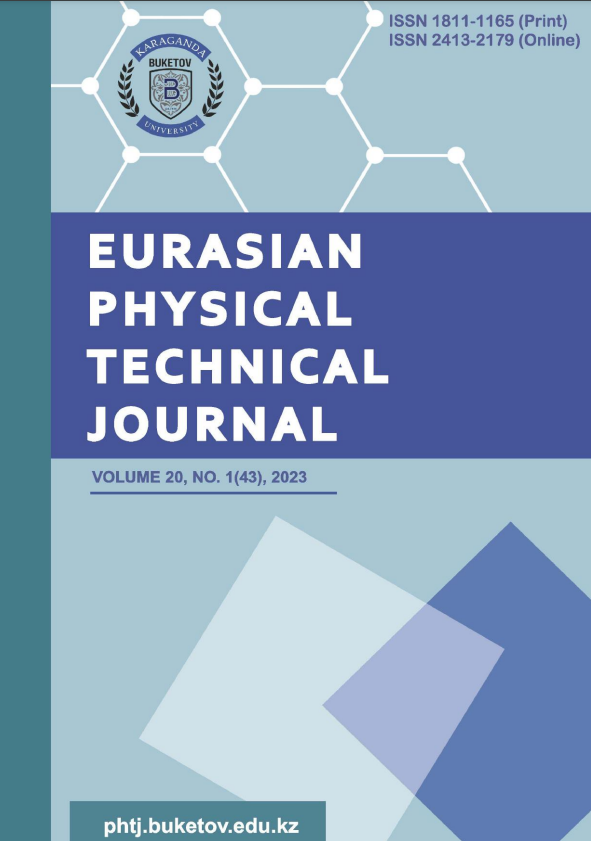The effect of molybdenum disulfide nanoparticles on the properties zinc oxide electron transport layer of organic solar cells
DOI:
https://doi.org/10.31489/2023No1/20-26Keywords:
zinc oxide, molybdenum disulfide, composite film, surface morphology, optical and impedance spectroscopyAbstract
In this work, the effect of molybdenum disulfide nanoparticles on the properties zinc oxide electron transport layer of organic solar cells is studied. molybdenum disulfide nanoparticles were obtained by laser ablation of MoS2 powder in isopropyl alcohol. To form composite films, nanoparticles were added to a sol–gel zinc oxide solution with different concentrations. According to scanning electron microscope study, as the concentration of nanoparticles in the film increases, the thickness of the molybdenum disulfide layer on the zinc oxide surface changes. molybdenum disulfide nanoparticles in the film structure gradually fill the bulk and surface voids in zinc oxide. However, when the concentration exceeds 1%, holes and voids are formed in the film. The absorption spectra of composite films showed that as the concentration of nanoparticles in the film increases, the absorption intensity enhances due to the increase of the overall thickness. At the same time, zinc oxide optical band gap width does not change, which means the molybdenum disulfide nanoparticles do not affect the electronic structure of zinc oxide. It was shown that the observed changes in the volt-ampere characteristic of organic solar cells with composite films electron transport layer composite films was associated with the influence of molybdenum disulfide nanoparticles on electron transport in organic solar cells. According to impedance spectroscopy study, it was found that molybdenum disulfide nanoparticles at concentration below critical value increases the lifetime of charge carriers and the diffusion coefficient in composite film.
References
Huang Yi-J., Chen H.-Ch., Lin H.-K. Doping ZnO Electron Transport Layers with MoS2 Nanosheets Enhances the Efficiency of Polymer Solar Cells. ACS Appl. Mater. Interfaces. 2018, pp. 1- 31. doi:10.1021/acsami.8b06413
Nian L., Zhang W., Zhu N. Photoconductive Cathode Interlayer for Highly Efficient Inverted Polymer Solar Cells. J. Am. Chem. Soc. 2015, 137 (22), pp. 6995 – 6998. doi:10.1021/jacs.5b02168
Nian L., Gao K., Liu F. 11% Efficient Ternary Organic Solar Cells with High Composition Tolerance via Integrated Near-IR Sensitization and Interface Engineering. Adv. Mater. 2016, pp. 8184 – 8190. doi:10.1002/adma.201602834
Nian L., Chen Z., Herbst S. Aqueous Solution Processed Photoconductive Cathode Interlayer for High Performance Polymer Solar Cells with Thick Interlayer and Thick Active Layer. Adv. Mater. 2016, pp.7521–7526. doi: 10.1002/adma.201601615
Liu X., Li X., Li Y. High-Performance Polymer Solar Cells with PCE of 10.42% via Al-Doped ZnO Cathode Interlayer. Adv. Mater. 2016, pp.7405–7412. doi:10.1002/adma.201601814
Yang Z., Zhang T., Li J. Multiple Electron Transporting Layers and Their Excellent Properties Based on Organic Solar Cell. Sci. Rep. 2017, 7 (1), 9571. doi:10.1038/s41598-017-08613-7
Lin Z., Chang J., Zhang C. Enhanced Performance and Stability Page 20 of 31 ACS Paragon Plus Environment ACS Applied Materials & Interfaces of Polymer Solar Cells by In Situ Formed AlOX Passivation and Doping. J. Phys. Chem. 2017, 121 (19), pp.10275–10281. doi:10.1021/acsami.0c09046
Liao S.H., Jhuo H.J. Cheng Y.S. Fullerene Derivative-Doped Zinc Oxide Nanofilm as the Cathode of Inverted Polymer Solar Cells with Low-Bandgap Polymer (PTB7-Th) for High Performance. Adv. Mater. 2013, 25 (34), pp.4766–4771. doi:10.1002/adma.201301476
Liao S.-H., Jhuo H.-J, Yeh P.-N. Single Junction Inverted Polymer Solar Cell Reaching Power Conversion Efficiency 10.31% by Employing Dual-Doped Zinc Oxide Nano-Film as Cathode Interlayer. Sci. Rep. 2015, 4 (1), 6813. doi:10.1038/srep06813
Wei J., Yin Z., Chen S. C., Low-Temperature Solution-Processed Zinc Tin Oxide Film as a Cathode Interlayer for Organic Solar Cells. ACS Appl. Mater. Interfaces, 2017, 9 (7), pp.6186–6193. doi:10.1021/acsami.6b13724
Yun J.M., Noh Y.J., Yeo JS. Efficient work-function engineering of solution processed MoS2 thin-films for novel hole and electron transport layers leading to high-performance polymer solar cells, J. Mater. Chem. 2013, pp.3777 – 3783. doi:10.1039/C3TC30504J
Ilyassov B., Ibrayev N., Hierarchically assembled nanostructures and their photovoltaic properties. J. Mater. Sci. Semicond. Process. 2015, 40, pp.885–889. doi:10.1016/j.mssp.2015.07.087
Aimukhanov A.K., Seisembekova T.E., Zeinidenov A.K., The impact of SnO2 photoelectrode’s thickness on photovoltaic properties of the solar cell FTO:SnO2:PTB7-TH:ITIC/Mo/Ag. Bulletin of the Karaganda University, series Physics. 2022, №2(106), pp.86-91. doi:10.31489/2022PH2/86-91
Zeinidenov A.K., Аimukhanov A.K., Ilyassov B.R. Impact of the annealing temperature of In2O3 films on the photovoltaic characteristics of a polymer solar cells. Eurasian Physical Technical Journal. 2022, Vol.19, №1(39). pp. 34–39. doi:10.31489/2022No1/34-39.
Gao M., Zhang M., Niu W. Tuning the transport behavior of centimeter-scale WTe2 ultrathin films fabricated by pulsed laser deposition. Appl. Phys. Lett. 2017, 111(3), 031906. doi:10.1063/1.4995227













